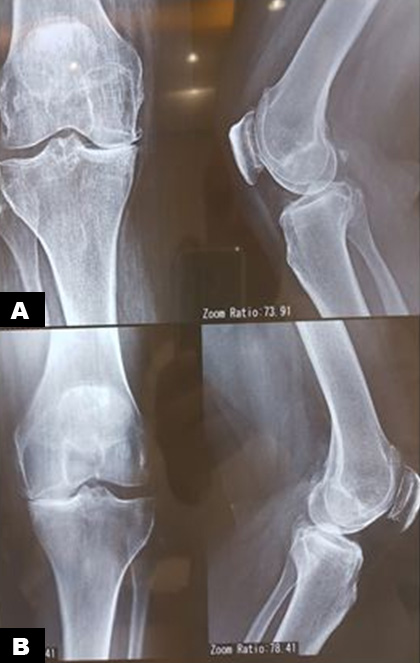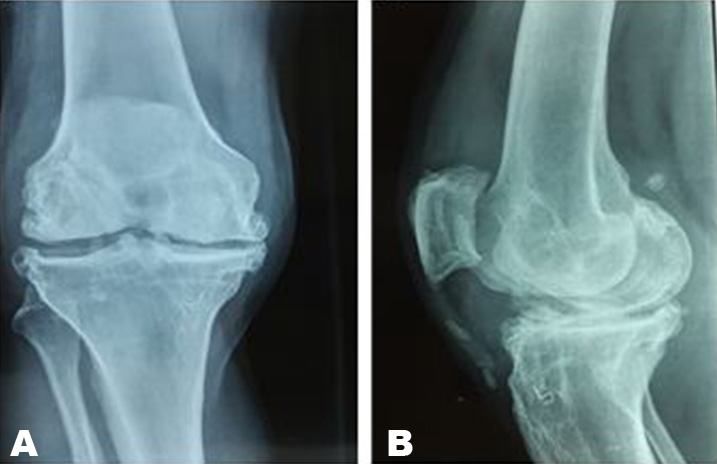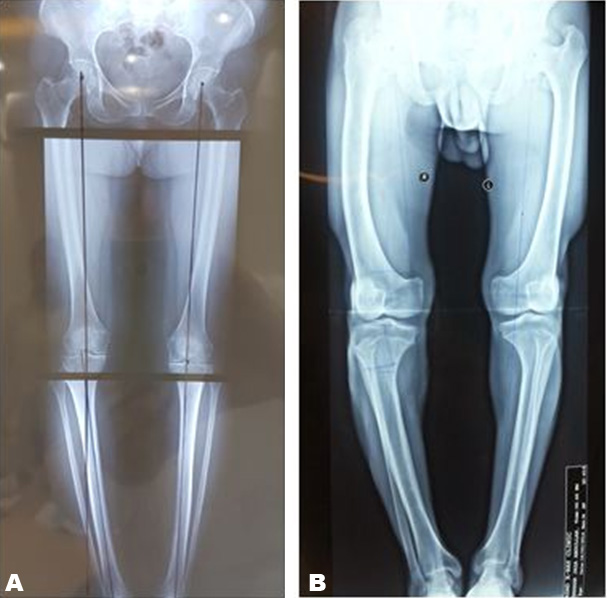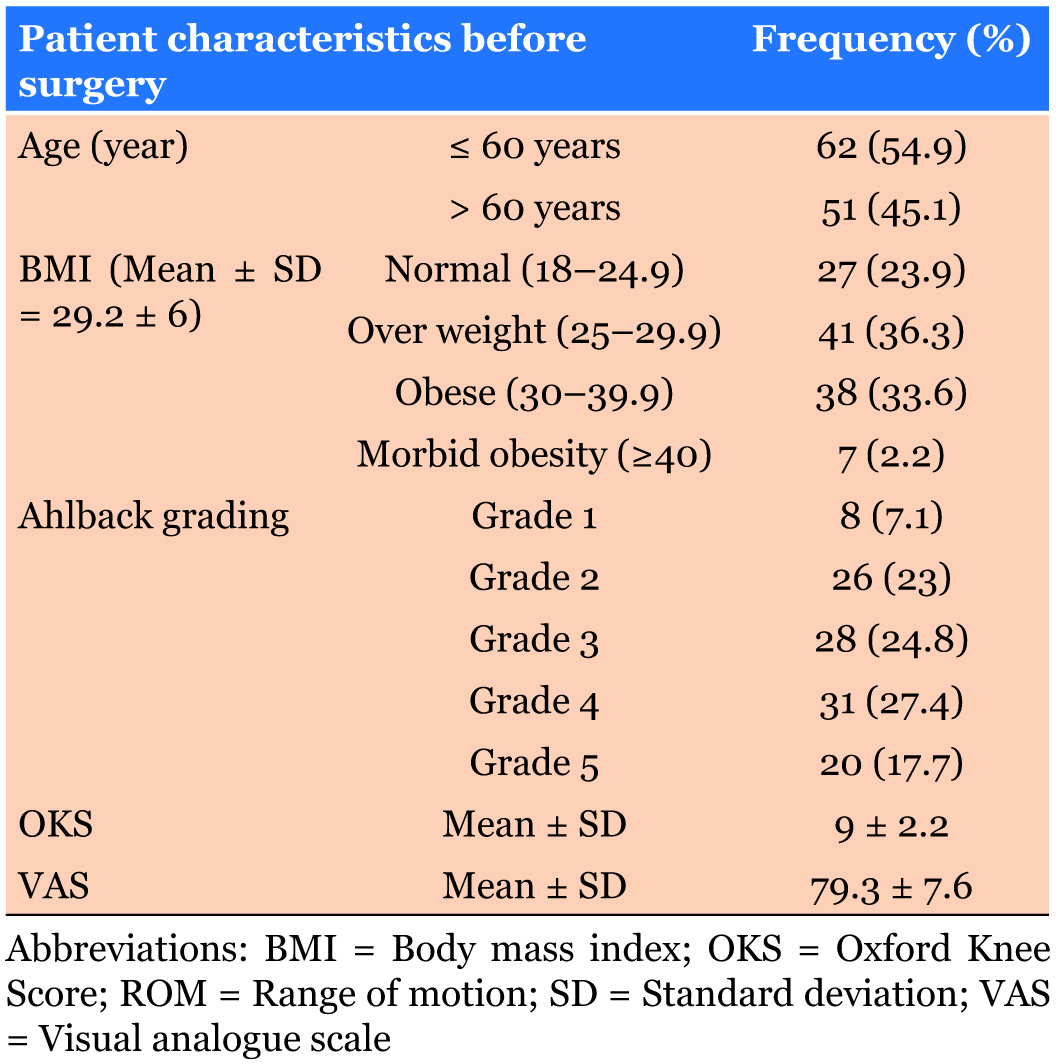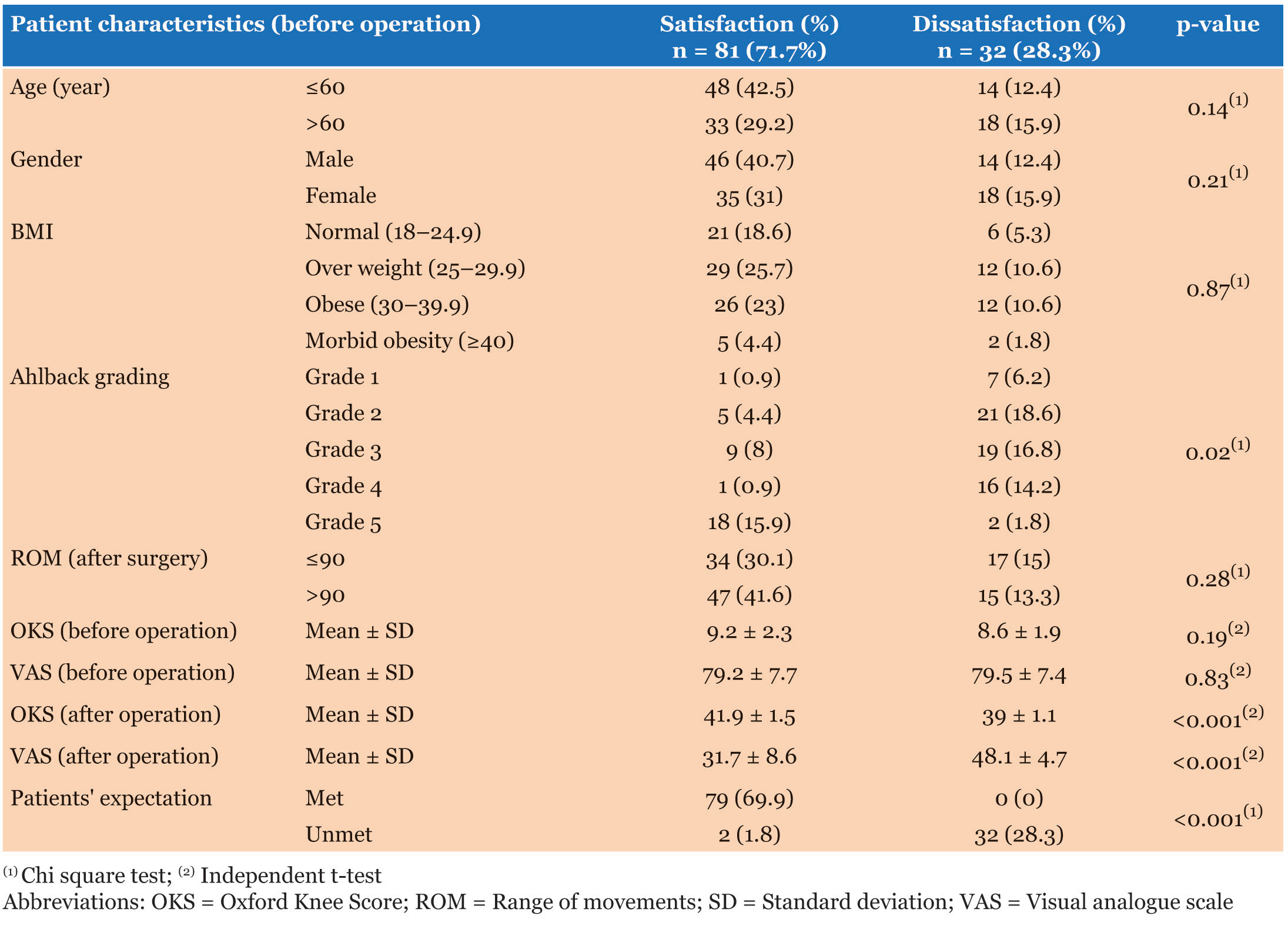 |
Research Articles
Patient satisfaction following primary total knee arthroplasty in Sulaimani city
1 Assistant Professor, Department of Orthopedic and Traumatology, Shar Teaching Hospital, and University of Sulaimani/School of Medicine, Sulaimani, Kurdistan Region, Iraq
2 Department of Orthopedic and Traumatology, Shar Teaching Hospital, Sulaimani, Kurdistan Region, Iraq
3 Department of Orthopedic, College of Medicine/Hawler Medical University, Hawler, Kurdistan Region, Iraq
Address correspondence to:
Dlshad J Mahmud
Department of Orthopedic and Traumatology, Shar Teaching Hospital, Sulaimani, Kurdistan Region 00964,
Iraq
Message to Corresponding Author
Article ID: 100014O03RF2019
Access full text article on other devices

Access PDF of article on other devices

How to cite this article
Fatah RMN, Mahmud DJ, Ahmad ZM. Patient satisfaction following primary total knee arthroplasty in Sulaimani city. Edorium J Orthop 2019;5:100014O03RF2019.ABSTRACT
Aims: The aim of our study was to assess the patient satisfaction after primary cemented total knee arthroplasty.
Methods: A prospective cohort study was performed on 113 patients with primary osteoarthritis of the knee during June 2014 to February 2017. Preoperative and six months postoperative data collected in three public and two private hospitals in Sulaimani governorate. The follow-up period was six months. Oxford knee scoring was used to assess the patient outcome. Pain was analyzed through visual analogue scale. Patients with other than primary osteoarthritis of knee were excluded.
Result: Male to female ratio was 1:1.1 with a mean age of 59 years. From a total number of 113 patients, 71.7% of the patients were satisfied.
Conclusion: Satisfaction after total knee arthroplasty remains multifactorial and complex in nature. Identification of risk factors for dissatisfaction before surgery may improve patient satisfaction rate and modify the outcome. Patient expectation was a major predictor of satisfaction followed by pain, function, and severity of the arthritis.
Keywords: Knee arthroplasty, Osteoarthritis, Satisfaction, Sulaimani
INTRODUCTION
Total knee arthroplasty (TKA) is a successful and cost-effective treatment for improving patients' pain and function due to arthritis and it is among the most successful and common major elective surgical operations [1],[2]. After the surgery, most patients improve their pain, self-reported physical functioning, and quality of life. Despite of the improvement in patient selection, surgical technique, and implant design for primary TKA, only 82–89% of the patients were satisfied [3],[4],[5],[6],[7]. The idea of patient satisfaction was first mentioned by Ware et al. in 1873 [8]. Moreover, patients' satisfaction is associated with many factors, such as patients' expectations, pain relief, and improvement in physical function. Due to its sophisticated nature, it is difficult to assess a reliable patient satisfaction because it is liable for biases due to effect of many cofactors [9]. The National Joint Registry (NJR) had considered the Oxford Knee Score (OKS) as a validated patient reported outcome measure (PROM) to assess the outcome of the patients after TKA [2]. The OKS is a reliable and valid patient-centered questionnaire for subjective assessment of pain and function of their knee, and it is easy to administer, simple, and suitable for long period follow-up [2],[10]. It comprises of 12 sections ─ five sections are related to pain and the other seven sections are related to functional capacity [2],[10]. Moreover, each section is rated from 1 to 5 in which score of 1 indicates more severe outcome [2],[10]. Then, the overall scores are added together which range from 12 to 60, with the higher scores corresponding to better outcomes [2],[10],[11]. There are differences between orthopedists and patients assessment of patients' satisfaction, especially in assessing pain and function [2]; orthopedists concern is for the range of motion, alignment, and stability, but patients are focusing more on overall function of the joint [12]. Although pain is the strongest factor that affects satisfaction more than function, it is less amenable to lifestyle and behavioral changes, and it causes a considerable distress [13]. The main objective of this study was to assess the patient satisfaction after primary cemented TKA in Sulaimani city.
MATERIALS AND METHODS
The prospective cohort study design was used and 113 patients were included in the study from June 2014 to February 2017. In addition, data were collected from different hospitals in Sulaimani city, and the approval of Research Ethical Committee and informed consent of the patients were obtained.
The inclusion criteria were primary osteoarthritis (OA) combined with disabling knee joint pain that interfered with daily activity and not responding to conservative treatment or arthroscopic management. Moreover, the exclusion criteria were secondary OA, bilateral simultaneous TKA, and contralateral TKA within the follow-up period.
After clinical examination, standard AP (anteroposterior), lateral and axial view X-rays were taken (Figure 1 and Figure 2). In addition, scanogram obtained in patients with short stature, severe deformities, or suspected bowing of femur and tibia (Figure 3).
During the operation, 1.5 g of Cefuroxime was given intravenously with induction as a prophylaxis and most of the patients received spinal anesthesia and the rest received general anesthesia (80 and 33 patients, respectively). In addition, tourniquet was used in all patients and drains were used when the surgeon preferred.
Thereafter, drain removed 24 hours postoperatively and rehabilitation program was started in the first postoperative day. Moreover, the patients discharged when they were able to actively flex their knees beyond 90 degrees and extend the knee and perform active straight leg rising. In addition, patients were examined on weekly basis, stitches were removed after 10–14 days and the patients were examined regularly every two months.
At the end of the six months postoperatively, a checking X-ray of the operated knee was taken and visual analogue scale (VAS), satisfaction rate, OKS, patient expectation, and range of motion (ROM) were recorded. Furthermore, the answers were divided into two groups: the satisfaction group and the expectation group, and each group was divided into two subgroups: satisfied and dissatisfied, and expectation was met or not met, respectively. Moreover, the severity of the pain after surgery was measured by using (0–100 score) of VAS in which 0 indicated no pain and 100 indicated severe pain. Moreover, ROM was obtained by using goniometer and broadly divided into two groups: those with ˃900 flexion of the knee and those with Ë‚900 flexion of the knee.
We used "IBM SPSS Statistics version 21" for the analysis of the data. Moreover, a p-value of (≤0.05) was considered as statistically significant.
RESULTS
Total number of 113 patients was collected; 60 males and 53 females with a male:female ratio of 1:1.1, and a mean ± SD (standard deviation) age of 59 ± 7 years. Moreover, patients' characteristics before surgery have been mentioned in Table 1.
Three patients developed prosthetic infection, two patients sustained periprosthetic fracture and one patient died during the follow-up. All of them were excluded from the study.
For 27 patients, contralateral TKA performed after six months from the initial surgery and they were included in the study.
There was significant improvement in pain severity and OKS (Table 2), and 81 patients (71.7%) were satisfied after TKA surgery (Table 3).
DISCUSSION
Patient's expectation is an important predicting factor for patient's satisfaction. Bourne et al. [14] showed that the expectation which was not met is considered as predictor of patient's dissatisfaction after TKA. Moreover, surgeon's expectations after TKA are lesser than the patient’s expectations; at the beginning, patients are concerned with pain relief and independent activity, but surgeons know that such expectations may not be fulfilled [15]. Therefore, surgeons should inform the patients about not fulfilled expectations. However, studies showed that good treatment of such expectations can positively influence patient's satisfaction [16],[17].
Patient satisfaction is defined as the degree at which the surgery fulfills the patient and it defines the outcome of surgery. Moreover, we concerned the patient's satisfaction in our study because the knee replacement was basically an elective procedure to restore joint alignment; on the other hand, the surgeon should be aware of the differences in the rate of satisfaction which are multifactorial [18].
Our study showed 71.7% satisfaction after TKA and there was a statistically significant relationship between outcome of TKA surgery measured by OKS and patients' satisfaction (p-value of <0.001) (Table 3). Furthermore, patients' satisfaction in other studies [5],[19],[20],[21] was slightly higher than our result; this may be due to the small sample size in our study, lack of multimodal pain control, and lack of sufficient physiotherapy in affiliated hospitals.
We also found a very close result of patients' expectation to the patients' satisfaction; only 2.5% from the satisfied patients (71.7%) were not meeting their expectations, but all of patients who were dissatisfied (28.3%) diet not meet their expectations with a highly statistically significant relationship (p-value of Ë‚0.001) (Table 3).
Studies [21] showed that 51–56% of the patients who were dissatisfied reported no adverse complaints from their knees in regard to pain and function. Reasonably, this is due to unrealistic expectation toward the outcome of the surgery because most of the patients have high expectations of the outcome after TKA [22],[23]. In our study, despite the VAS score of 36.4 ± 10.7 after the surgery (Table 2), 97.5% from the satisfied patients met their expectation (Table 3), i.e., preoperative expectation defined the patients' satisfaction. Therefore, preoperative expectation should be managed. In addition, the severity of pain measured by VAS was significantly decreased by TKA (p-value of <0.001) (Table 2).
Other variables such as age, gender, body mass index (BMI), and ROM were weak predictors for patients' satisfaction, i.e., statistically insignificant relationships (Table 3). Furthermore, the satisfied patients were slightly younger than patients who dissatisfied because the perception of symptoms is affected by age ─ younger patients may consider disability and pain as more severe than do older patients [24], although older patients were associated with higher dissatisfaction [1],[25],[26]. In our study, same was true for BMI; lesser BMI had better satisfaction (Table 3). Moreover, Spicer et al. [27] showed that BMI of >30 kg/m2 was associated with a higher revision rate and poorer outcomes, while Singh et al. [28] showed that BMI was positively correlated with worse functional impairments. Conversely, several other studies [1],[24],[28] showed significant functional improvement and higher quality of life score in obese patients after TKA as compared to non-obese patients who did not undergo TKA. Concurrently, female gender was slightly less satisfied with the result of their TKA (Table 3).
The effect of ROM for knee joint on the patients' satisfaction was statistically insignificant in our study (Table 3). Conversely, function undoubtedly affects the patients' satisfaction because dissatisfaction depends on abnormal biomechanical function of the joint [29].
The degree of radiographic severity of OA of knee can affect the satisfaction rate after TKA. Our results showed a significant relationship between low radiographic grades which measured by Ahlback grading and dissatisfaction (Table 3). Moreover, this result supports the recommendation suggested by previous studies [30],[31],[32],[33] for performing surgery to patients with severe radiological damage.
At the end of follow-up period, i.e., at the end of six months, mean ± SD of OKS was 41.1 ± 1.9 (maximum OKS was 48) (Table 2) and the more the OKS improved the patients' satisfaction became better (Table 3).
Preoperative pain and function are predictors of postoperative OKS [34]. Our study supported this finding; a lack of improvement in pain in the operated knee is a significant independent predictor of dissatisfaction (Table 3). In addition, the satisfied patients had a significantly better VAS score (Table 3). Moreover, pain at this stage of six months follow-up does not stay permanently and it will change, as the study of Brander et al. [35] showed progressive improvement at five years follow-up duration and almost all of them were satisfied by the same period. Thereof, priorities differ between patients ─ one patient may accept residual pain but the other may tolerate a degree of functional limitation but not pain [2].
CONCLUSION
Patient expectation can affect the satisfaction rate after surgery and it is the major risk factor for controlling it. Other factors such as residual pain around the knee, function of the replaced knee, and the severity of the arthritis before the surgery are also important contributing factors. Conversely, gender, BMI, and OKS add little influence on the satisfaction rate. Hence, we recommend spending more time with the patients before surgery and discussion of the unrealistic expectation toward the outcome of surgery. In addition, more attention is required for pain control and better quality of physiotherapy in the hospitals, especially in the immediate postoperative period.
REFERENCES
1.
Birdsall PD, Hayes JH, Cleary R, Pinder IM, Moran CG, Sher JL. Health outcome after total knee replacement in the very elderly. J Bone Joint Surg Br 1999;81(4):660–2.
[Pubmed]

2.
Baker PN, van der Meulen JH, Lewsey J, Gregg PJ; National Joint Registry for England and Wales. The role of pain and function in determining patient satisfaction after total knee replacement: Data from the National Joint Registry for England and Wales. J Bone Joint Surg Br 2007;89(7):893–900. [CrossRef]
[Pubmed]

3.
Anderson JG, Wixson RL, Tsai D, Stulberg SD, Chang RW. Functional outcome and patient satisfaction in total knee patients over the age of 75. J Arthroplasty 1996;11(7):831–40. [CrossRef]
[Pubmed]

4.
Chesworth BM, Mahomed NN, Bourne RB, Davis AM; OJRR Study Group. Willingness to go through surgery again validated the WOMAC clinically important difference from THR/TKR surgery. J Clin Epidemiol 2008;61(9):907–18. [CrossRef]
[Pubmed]

5.
Dunbar MJ, Robertsson O, Ryd L, Lidgren L. Appropriate questionnaires for knee arthroplasty. Result of a survey of 3600 patients from The Swedish Knee Arthroplasty Registery. J Bone Joint Surg Br 2001;83(3):339–44.
[Pubmed]

6.
Hawker G, Wright J, Coyte P, et al. Health-related quality of life after knee replacement. J Bone Joint Surg Am 1998;80(2):163–73. [CrossRef]
[Pubmed]

7.
Heck DA, Robinson RL, Partridge CM, Lubitz RM, Freund DA. Patient outcome after knee replacement. Clin Orthop Relat Res 1998;(356):93–110. [CrossRef]
[Pubmed]

8.
9.
Ethgen O, Bruyère O, Richy F, Dardennes C, Reginster JY. Health-related quality of life in total hip and total knee arthroplasty. A qualitative and systematic review of the literature. J Bone Joint Surg Br Am 2004;86(5):963–74.
[Pubmed]

10.
Dawson J, Fitzpatrick R, Carr A, Murray D. Questionnaire on the perceptions of patient about total hip replacement. J Bone Joint Surg Br 1996;78(2):185–90.
[Pubmed]

11.
Petersen CL, Kjærsgaard JB, Kjærgaard N, Jensen MU, Laursen MB. Thresholds for Oxford Knee Score after total knee replacement surgery: A novel approach to post-operative evaluation. J Orthop Surg Res 2017;12(1):89. [CrossRef]
[Pubmed]

12.
Bullens HP, van Loon CJ, de Waal Malefijt MC, Laan FR, Veth RP. Patient satisfaction after total knee arthroplasty: A comparison between subjective and objective outcome assessments. J Arthroplasty 2001;16(6):740–7. [CrossRef]
[Pubmed]

13.
Barrak RL, Ruh EL, Chen J, et al. Impact of socioeconomic factors on outcome of total knee arthroplasty. Clin Orthop Relat Res 2014;472(1):86–97. [CrossRef]
[Pubmed]

14.
Bourne RB, Chesworth BM, Davis AM, Mahomed NN, Charron KD. Patient satisfaction after total knee arthroplasty: Who is satisfied and who is not? Clin Orthop Relat Res 2010;468(1):57–63. [CrossRef]
[Pubmed]

15.
Noble PC, Fuller-Lafreniere S, Meftah M, Dwyer MK. Challenge in outcome measurement: Discrepancies between patient and provider definition of success. Clin Orthop Relat Res 2013;471(11):3437–45. [CrossRef]
[Pubmed]

16.
Weiss JM, Noble PC, Conditt MA, et al. What functional activities are important to patient with knee replacement? Clin Orthop Relat Res 2002;(404):172–88.
[Pubmed]

17.
Nilsdotter AK, Toksvig-Larsen S, Roos EM. Knee arthroplasty: Are patients' expectations fulfilled? A prospective study of pain and function in 102 patients with 5-year follow-up. Acta Orthop 2009;80(1):55–61. [CrossRef]
[Pubmed]

18.
Noble PC, Conditt MA, Cook KF, Mathis KB. The John Insall Award: Patient expectations affect satisfaction with total knee arthroplasty. Clin Orthop Relat Res 2006;452:35–43. [CrossRef]
[Pubmed]

19.
Robertsson O, Dunbar M, Pehrsson T, Knutson K, Lidgren L. Patient satisfaction after knee arthroplasty: A report on 27,372 knees operated on between 1981 and 1995 in Sweden. Acta Orthop Scand 2000;71(3):262–7. [CrossRef]
[Pubmed]

20.
Gandhi R, Davey JR, Mahomed N. Patient expectations predict greater pain relief with joint arthroplasty. J Arthroplasty 2009;24(5):716–21. [CrossRef]
[Pubmed]

21.
Kim TK, Chang CB, Kang YG, Kim SJ, Seong SC. Causes and predictors of patient's dissatisfaction after uncomplicated total knee arthroplasty. J Arthroplasty 2009;24(2):263–71. [CrossRef]
[Pubmed]

22.
Mahomed NN, Liang MH, Cook EF, et al. The importance of patient expectations in predicting functional outcomes after total joint arthroplasty. J Rheumatol 2002;29(6):1273–9.
[Pubmed]

23.
McGuigan FX, Hozack WJ, Moriarty L, Eng K, Rothman RH. Predicting quality-of-life outcomes following total joint arthroplasty. Limitations of the SF-36 health status questionnaire. J Arthroplasty 1995;10(6):742–7.
[Pubmed]

24.
Rajgopal V, Bourne RB, Chesworth BM, MacDonald SJ, McCalden RW, Rorabeck CH. The impact of morbid obesity on patient outcomes after total knee arthroplasty. J Arthroplasty 2008;23(6):795–800. [CrossRef]
[Pubmed]

25.
Gandhi R, Davey JR, Mahomed NN. Predicting patient dissatisfaction following joint replacement surgery. J Rheumatol 2008;35(12):2415–8. [CrossRef]
[Pubmed]

26.
Noble PC, Gordon MJ, Weiss JM, Reddix RN, Conditt MA, Mathis KB. Does total knee replacement restore normal knee function? Clin Orthop Relat Res 2005;(431):157–65.
[Pubmed]

27.
Spicer DD, Pomeroy DL, Badenhausen WE, et al. Body mass index as a predictor of outcome in total knee replacement. Int Orthop 2001;25(4):246–9. [CrossRef]
[Pubmed]

28.
Singh JA, O'Byrne M, Harmsen S, Lewallen D. Predictors of moderate-severe functional limitation after primary Total Knee Arthroplasty (TKA): 4701 TKAs at 2-years and 2935 TKAs at 5-years. Osteoarthritis Cartilage 2010;18(4):515–21. [CrossRef]
[Pubmed]

29.
Singh JA, O'Byrne MM, Calligan RC, Lewallen DG. Pessimistic explanatory style: A psychological risk factor for poor pain and functional outcomes two years after knee replacement. J Bone Joint Surg Br 2010;92(6):799–806. [CrossRef]
[Pubmed]

30.
Dieppe P, Basler HD, Chard J, et al. Knee replacement surgery for osteoarthritis: Effectiveness, practice variations, indications and possible determinants of utilization. Rheumatology (Oxford) 1999;38(1):73–83. [CrossRef]
[Pubmed]

31.
Hamel MB, Toth M, Legedza A, Rosen MP. Joint replacement surgery in elderly patients with severe osteoarthritis of the hip or knee: Decision making, postoperative recovery, and clinical outcomes. Arch Intern Med 2008;168(13):1430–40. [CrossRef]
[Pubmed]

32.
Peck CN, childs J, McLauchlan GJ. Inferior outcomes of total knee replacement in early radiological stages of osteoarthritis. Knee 2014;21(6):1229–32. [CrossRef]
[Pubmed]

33.
Dawson J, Fitzpatrick R, Carr A, Murray D. Questionnaire on the perceptions of patients about total hip replacement. J Bone Joint Surg Br 1996;78(2):185–90.
[Pubmed]

34.
Murray DW, Fitzpatrick R, Rogers K, et al. The use of the Oxford hip and knee scores. J Bone Joint Surg Br 2007;89(8):1010–4. [CrossRef]
[Pubmed]

35.
Brander V, Gondek S, Martin E, Stulberg SD. Pain and depression influence outcome 5 years after knee replacement surgery. Clin Orthop Relat Res 2007;464:21–6.
[Pubmed]

SUPPORTING INFORMATION
Acknowledgments
We are thankful for
Author ContributionsRebar M Noori Fatah - Conception of the work, Design of the work, Analysis of data, Revising the work critically for important intellectual content, Final approval of the version to be published, Agree to be accountable for all aspects of the work in ensuring that questions related to the accuracy or integrity of any part of the work are appropriately investigated and resolved.
Dlshad J Mahmud - Conception of the work, Design of the work, Acquisition of data, Final approval of the version to be published, Agree to be accountable for all aspects of the work in ensuring that questions related to the accuracy or integrity of any part of the work are appropriately investigated and resolved.
Zohair Mohsin Ahmad - Conception of the work, Design of the work, Revising the work critically for important intellectual content, Final approval of the version to be published, Agree to be accountable for all aspects of the work in ensuring that questions related to the accuracy or integrity of any part of the work are appropriately investigated and resolved.
Guaranter of SubmissionThe corresponding author is the guarantor of submission.
Source of SupportNone
Consent StatementWritten informed consent was obtained from the patient for publication of this article.
Data AvailabilityAll relevant data are within the paper and its Supporting Information files.
Conflict of InterestAuthors declare no conflict of interest.
Copyright© 2019 Rebar M.Noori Fatah et al. This article is distributed under the terms of Creative Commons Attribution License which permits unrestricted use, distribution and reproduction in any medium provided the original author(s) and original publisher are properly credited. Please see the copyright policy on the journal website for more information.


